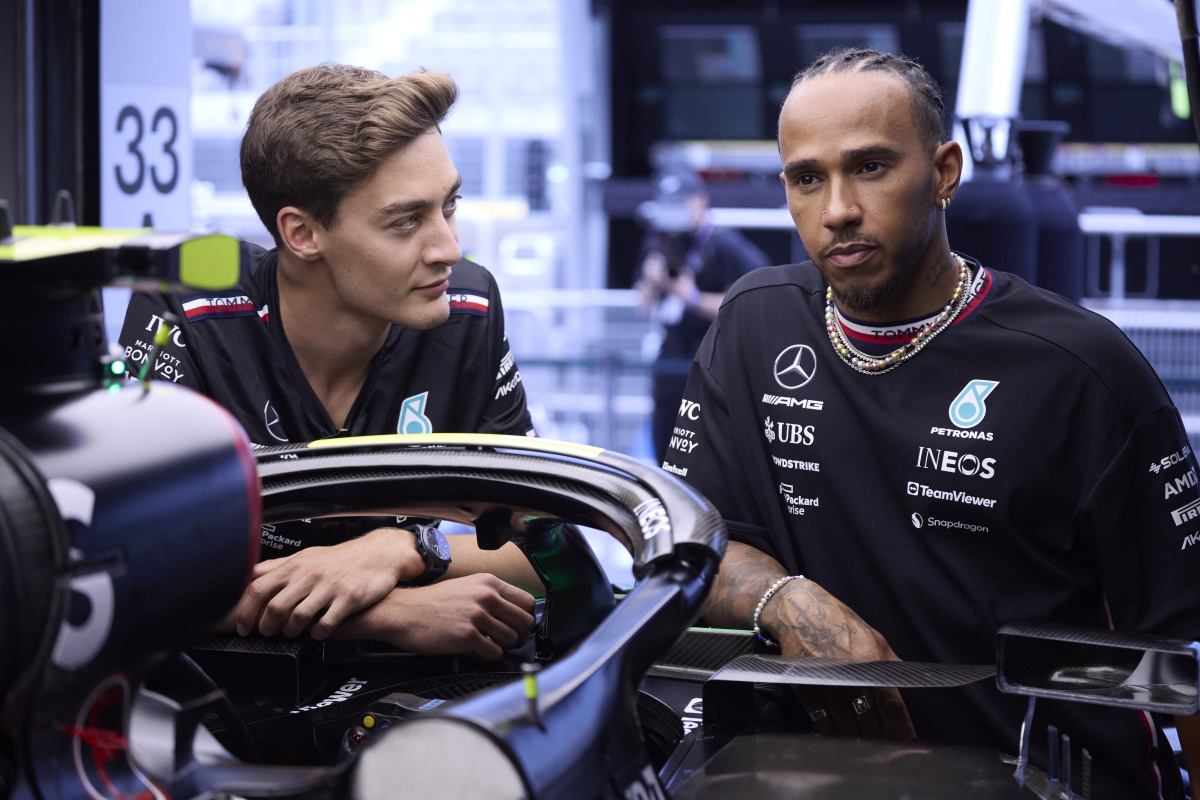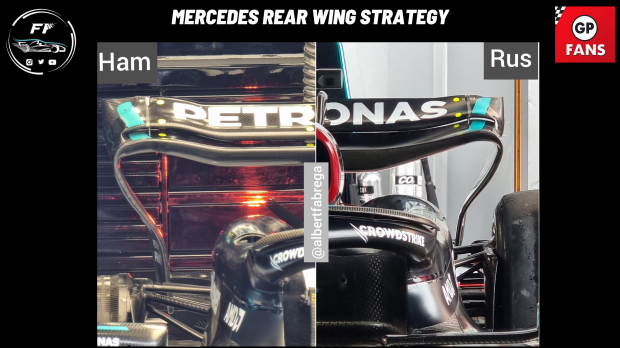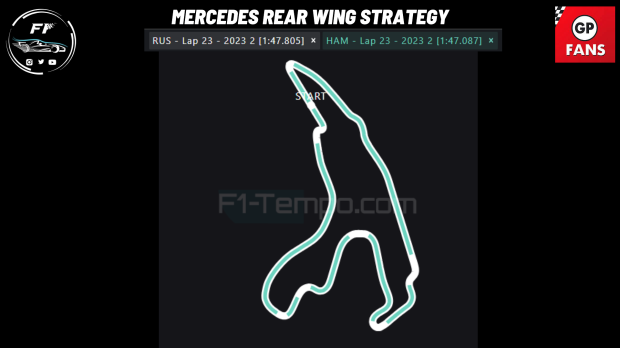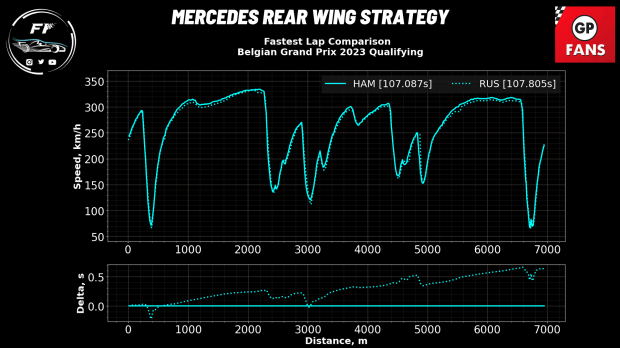
Aero EXPERT explains why Mercedes rear wing decision helped Hamilton
Aero EXPERT explains why Mercedes rear wing decision helped Hamilton

Mercedes brought a significant aero update package to Spa, showing signs of them converging to the aero trends on other top F1 cars on this grid. In a qualifying session which went from wet to dry between the Q1, Q2, and Q3 sessions, everyone found themselves in a 'track evolution game'.
The later you could set the lap, the higher your chances were of securing a top position. However, what was distinctively different was that Mercedes decided to go to onto two different setups on George Russell and Lewis Hamilton's cars.
Hamilton preferred a low drag setup, while Russell chose a high downforce setup which eventually led to him being at a disadvantage. In this article, let us dissect how Hamilton's low drag setup put him on the front row of the grid for Sunday.
Visual differences

Aerodynamically, you can see from the above image the rear wing differences between the two drivers. Hamilton's wing is much 'flatter' and hence less draggy, while Russell's rear wing is deeper, thus producing more downforce and thus more resistance.
Track Dominance Plots

From these track dominance plots, we can see that Hamilton is faster in all the high-speed sections of the track. He’s faster in all the traction zones as well.
This setup really worked well for Hamilton, there is definitely more to this than just the rear wing setup as it's impressive that he can match Russell on all the exits of slow and medium-speed corners as well.
Telemetry Data Analysis

The telemetry plots clearly show that Hamilton was around ~5 km/hr faster across all the traction zones leading to straights. When we look at the delta plot we can see that Hamilton was faster than his team-mate across the entire track as the delta increases linearly over the entire lap.
Shubham Sangodkar is a former F1 Aerodynamicist with a Masters in Racing Car Design specialising in F1 Aerodynamics and F1 Data Analysis. He also posts aerodynamics content on his YouTube channel, which can be found here.
Related
Change your timezone:
Latest News

F1 team OFFICIALLY confirms signing of new lead driver
- 27 minutes ago

F1 News Today: Hamilton hints Newey Ferrari move as Verstappen takes swipe at F1 rival
- 2 hours ago

Newey Red Bull EXIT date revealed as F1 star confirmed at new team - GPFans F1 Recap
- Yesterday 23:57

Verstappen takes F1 swipe at Hamilton and rivals with ruthless remark
- Yesterday 22:57

Marko defends Ricciardo in 'unbelievable' idiot claim
- Yesterday 21:57

Hamilton hints at sensational Newey arrival at Ferrari
- Yesterday 20:57
Related news

Legendary F1 circuit could be ditched due to spiralling costs

F1 confirms renewal of KEY race contract until 2025

Brundle names the ONE F1 driver operating well above expectations

F1 legend slams UNFAIR FIA proposal after 'deceiving fans'
F1 Standings

Drivers
- Oliver Bearman
- Charles Leclerc
- Carlos Sainz
- Lando Norris
- Oscar Piastri
- Pierre Gasly
- Esteban Ocon
- Sergio Pérez
- Max Verstappen
- Alexander Albon
- Logan Sargeant
- Lewis Hamilton
- George Russell
- Nico Hülkenberg
- Kevin Magnussen
- Fernando Alonso
- Lance Stroll
- Valtteri Bottas
- Zhou Guanyu
- Daniel Ricciardo
- Yuki Tsunoda
Races
-
 Gulf Air Grand Prix of Bahrain 2024
Gulf Air Grand Prix of Bahrain 2024
-
 Saudi Arabian Grand Prix 2024
Saudi Arabian Grand Prix 2024
-
 Grand Prix of Australia 2024
Grand Prix of Australia 2024
-
 MSC Cruises Grand Prix of Japan 2024
MSC Cruises Grand Prix of Japan 2024
-
 Grand Prix of China 2024
Grand Prix of China 2024
-
 Miami Grand Prix 2024
Miami Grand Prix 2024
-
 Gran Premio dell'Emilia Romagna 2024
Gran Premio dell'Emilia Romagna 2024
-
 Grand Prix of Monaco 2024
Grand Prix of Monaco 2024
-
 Grand Prix du Canada 2024
Grand Prix du Canada 2024
-
 Gran Premio de España 2024
Gran Premio de España 2024
-
 Grand Prix of Austria 2024
Grand Prix of Austria 2024
-
 Grand Prix of Great Britain 2024
Grand Prix of Great Britain 2024
-
 Grand Prix of Hungary 2024
Grand Prix of Hungary 2024
-
 Grand Prix of Belgium 2024
Grand Prix of Belgium 2024
-
 Heineken Dutch Grand Prix 2024
Heineken Dutch Grand Prix 2024
-
 Grand Prix of Italy 2024
Grand Prix of Italy 2024
-
 Grand Prix of Azerbaijan 2024
Grand Prix of Azerbaijan 2024
-
 Grand Prix of Singapore 2024
Grand Prix of Singapore 2024
-
 Grand Prix of the United States 2024
Grand Prix of the United States 2024
-
 Gran Premio de la Ciudad de Mexico 2024
Gran Premio de la Ciudad de Mexico 2024
-
 Grande Prêmio de São Paulo 2024
Grande Prêmio de São Paulo 2024
-
 Heineken Silver Las Vegas Grand Prix 2024
Heineken Silver Las Vegas Grand Prix 2024
-
 Qatar Grand Prix 2024
Qatar Grand Prix 2024
-
 Grand Prix of Abu Dhabi 2024
Grand Prix of Abu Dhabi 2024
About GPFans
GPFans is a multi-platform, multi-language brand dedicated to Formula One coverage. We bring you all the ins and outs of the sport, 24/7, everything from up-to-the-minute news and features to the latest viral stories and clips.We believe that a new generation of exciting, outspoken drivers will make F1 more popular than ever before, and we want to give our users access to as much of their heroes as possible, on and off the track. From Lewis Hamilton to Max Verstappen, Daniel Ricciardo to Sebastian Vettel, we provide in-depth analysis of every every Grand Prix in the season, from Australia to Abu Dhabi.
With Formula One under the new ownership of Liberty Media, how the sport is being covered is evolving, and GPFans will look to be at the heart of this progression into new media, as one of the fastest-growing sites covering the king of motorsports.
Follow us on your favorite social media channel
Corporate & Media
 Innovatieweg 20C
Innovatieweg 20C7007 CD, Doetinchem, Netherlands
+31645516860


















 Gulf Air Grand Prix of Bahrain 2024
Gulf Air Grand Prix of Bahrain 2024  Saudi Arabian Grand Prix 2024
Saudi Arabian Grand Prix 2024  Grand Prix of Australia 2024
Grand Prix of Australia 2024  MSC Cruises Grand Prix of Japan 2024
MSC Cruises Grand Prix of Japan 2024  Grand Prix of China 2024
Grand Prix of China 2024  Gran Premio dell'Emilia Romagna 2024
Gran Premio dell'Emilia Romagna 2024  Grand Prix of Monaco 2024
Grand Prix of Monaco 2024  Grand Prix du Canada 2024
Grand Prix du Canada 2024  Gran Premio de España 2024
Gran Premio de España 2024  Grand Prix of Austria 2024
Grand Prix of Austria 2024  Grand Prix of Hungary 2024
Grand Prix of Hungary 2024  Grand Prix of Belgium 2024
Grand Prix of Belgium 2024  Grand Prix of Azerbaijan 2024
Grand Prix of Azerbaijan 2024  Grand Prix of Singapore 2024
Grand Prix of Singapore 2024  Gran Premio de la Ciudad de Mexico 2024
Gran Premio de la Ciudad de Mexico 2024  Grande Prêmio de São Paulo 2024
Grande Prêmio de São Paulo 2024  Qatar Grand Prix 2024
Qatar Grand Prix 2024  Grand Prix of Abu Dhabi 2024
Grand Prix of Abu Dhabi 2024